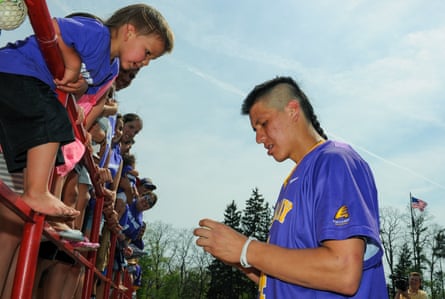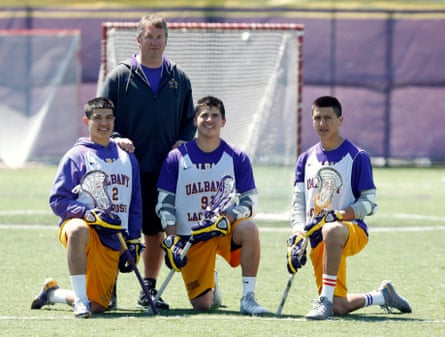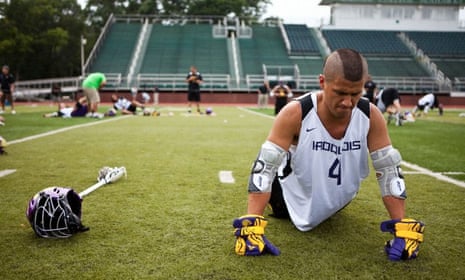There was a moment in Jeremy Thompson’s life when he realized he had to make a decision. A teenager raised in the proud traditions of the Onondaga Nation, he was at a crossroads. On one side, he had lacrosse. On the other, he had the drugs, the alcohol, the youthful escapes so many teenagers embrace.
Thompson had started down the path most traveled, the path that too often robs Native American youth of their potential futures. He knew he was letting his family down. His father recognized his pain, and asked his oldest son to take a walk with him. They wandered behind their house, through the woods, to a gorge, where they sat along the river. They sat in silence.
Eventually, his father looked at him. “What do you see?” Jerome Thompson asked. Jeremy looked at the water. He listened, and he thought through his feelings. They continued to sit in silence, until he looked at his father. “I see water,” he said. In that simple phrase, he conveyed volumes.
“What I meant was that I see the water being an unstoppable force. The water flowed over trees, rocks, through cracks, what obstacle was in water’s way it didn’t matter,” Jeremy explains today. “Water kept on its path and continued to move forward. From that point on I put myself in as that water, I was not going to let obstacles like drugs and alcohol hold me back, I was going to overcome whatever was in my way, stopping me from my true purpose.”
For Jeremy and his three younger brothers, that true purpose is lacrosse. They’ve embraced the sport, and they’ve seen success unprecedented in their community. Jeremy, Haina, Miles and Lyle are now the face of Nike’s growing lacrosse brand. And through their partnership, they’re hoping to help other Native American youth see the value in choosing the path less traveled. They have their best shot of doing so this week, as their nation hosts the World Indoor Lacrosse Championships. This is the first time an indigenous nation is hosting an international tournament, and the Thompsons hope to lead the team to its first WILC gold. But as special as that would be, they’re playing for something even bigger.

The first lacrosse game looked nothing like those contested today. It took place “on the other side of the stars, before there were humans”, as Jeremy tells it. Land animals and birds faced off. The Creator found the game entertaining, and passed it on to humans as a form of medicine, a game with the power to heal community disputes as well as nourish the ill. It has been played ever since, known to Natives as ‘Deyhontsigwa’ehs’, which roughly translates to ‘they bump hips’. It was also known as ‘tewaaraton’ and ‘baggataway’ among different tribes.
While Natives created it, white settlers eventually adopted it as their own. The French named it ‘la crosse’ in the 1600s, because the wooden sticks looked similar to those carried by bishops. By the mid-1800s, the world had caught on to the game. A Canadian organization formed in 1867. It added official rules and more structure, giving it its modern look. The white clubs originally competed against Native teams. Eventually, though, they banned Native teams altogether, because they were just too good. And when the first World Field Lacrosse Championship was hosted in 1968, the Iroquois Nationals were not invited. They had to fight to earn respect in a sport they’d created.
As lacrosse became a college sport in the US, preppy east coast players dominated. There have been a handful of Native stars – Dave White, Neal Powless, Tony Gray, Brett Bucktooth, to name a few – but for all the boys who grew up playing the game, few make it to the college level. Many more becomes statistics in the pervasive rates of alcoholism, drug abuse, and teen suicide that plague the reservations, that nearly stole Jeremy from the lacrosse scene. At about 30%, the high school drop-out rate among reservation kids is more than double the average in the rest of the US. Lyle can think of at least five or six friends who showed immense talent, who he thinks could have changed the game if they’d stuck with lacrosse. They chose other paths instead, he says. “This is a culmination of our history and the things that happened to Native Americans,” says Lyle. “Some find a way to use that as an excuse. I found a way to use it as motivation.”

The Thompsons’ grandparents and parents – and having each other – were instrumental in the their ability to escape the ghosts that haunt so many of their people. Each was given a wooden lacrosse stick at birth, and rarely, if ever, put it down. They played their first games in their backyard, where their father had covered the goal with slab of wood. He cut a hole almost exactly the size of a ball, forcing them to shoot with pinpoint accuracy if they wanted to score. They didn’t have much, in material terms. But they had family, they had love, and they had lacrosse. They grew up watching Jerome play with the Iroquois Nationals. He always worked with them. Through constant pick-up games and one-on-one face-offs, the boys each developed a unique playing style. Jeremy explains that each now embodies the style of one of the animals that played in the original game.
Jeremy resembles the deer, because he’s versatile, able to do everything from face-offs to defense and offense. Hiana is the wolf, because he plays best with his family, he’s agile and aggressive. Miles is the bear. “He’s big and strong and he has the best hands in the game,” says Jeremy. “Often times I imagine a bear standing on a rock in a rushing river catching salmon.” Lyle is the eagle. “He’s visionary, creative and game-changing.”
The boys started playing organized lacrosse later than most future college stars, but that never held them back. By the time they reached high school, everyone expected them to go to Syracuse University. The Orange had always been the destination for Native lacrosse players who chose the college route. Jeremy played two years at a community college, then followed the expected course, playing at Syracuse for his last two years. Miles and Lyle decided they’d explore their options before committing. They wanted to look beyond Syracuse, where they felt their loyalty was being taken for granted. They eventually chose the University at Albany, a decision that left their first lasting mark on the game and their community.
“Before Miles and I attended Albany, there was a notion that Natives should not go off to school. And [that] if they did, they would not come back to their traditional ways,” says Lyle. “Miles and I, always talked about going off to school and still staying connected to our culture to show other Natives that it’s possible.”

They stuck to this plan beautifully throughout their record-setting years of college lacrosse – they wore their hair in three-foot braids as they set NCAA scoring and assist records; Lyle welcomed his first daughter during his freshman year of college, at an age that is common in Native American culture. They wore traditional attire when they became the first Native recipients (and first co-recipients) of the Tewaaraton Award, which essentially the Heisman Trophy of lacrosse. The bronze trophy shows a Mohawk player and is mounted on a hexagon-shaped base, the six sides representing the six nationals of the Iroquois Confederacy. They were the first Native players to even be nominated. Lyle cried as he and Miles accepted it last year. This spring, Lyle won his second Tewaaraton Award. Lyle graduated from Albany this May, and he and his fiancée welcomed their third child in August. All four Thompson brothers are working on building houses near their parents’ home, so that they can raise their children in the only way they’ve ever known: surrounded by family, immersed in their culture.
Their choice of Albany over Syracuse also changed the way college coaches recruit on the reservations. University of Denver coach Bill Tierney credits Lyle’s decision with encouraging more coaches to consider recruiting Natives. He says it’s what led him to recruit Zach Miller, who this year led Denver to its first NCAA national lacrosse title – the first won by a school not located on the East Coast. Last year, there were 33 Native American NCAA lacrosse players representing 16 colleges, as well as five coaches. That’s a small fraction of the number of Native American kids who grow up playing the sport, but this is slowly changing, in large part due to Miles and Lyle’s success at Albany. Even as they’ve moved on from college lacrosse, they’re continuing to show younger players all that lacrosse can bring them. All four now play professional lacrosse, and all are sponsored by Nike.
Speaking at an elite Nike lacrosse camp this July, Jeremy marveled at the many ways lacrosse has continued to change their lives. They didn’t have running water until they were in middle school, he said. Now they were standing on a field at the Nike headquarters, Snapchatting on their smartphones. An hour earlier the brothers had helped launch a new Nike cleat that features a Thompson “T” on the tongue and heel. Jeremy helped design it. The blue swoosh on the side represents water, the inspiration he needed to overcome his personal obstacles.
A lot of reservation youth don’t even know these opportunities exist, never mind that they could have them, he said. The brothers spend as much time as they can spreading these messages on the reservations, working with youth at camps and any other opportunity. This week, they have their chance to reach so many more.
The Iroquois team has taken silver at the three previous WILCs, each time losing to Canada in tightly-contested battles. They lost by one goal four years ago. This year, playing at home, the team has its best chance at finally overcoming its neighbors to the north. They already opened the tournament with a 13-9 victory over the US, winning on the power of a combined six goals from Miles and Lyle. Lyle says they are playing for a larger purpose, but there is no denying the how much it would mean to the family and the nation to win at home.
“If we win the gold it would be a storybook ending,” says Jeremy. “Hosting the games here and winning in front of our hometown would be amazing.”
- This article was amended on 24 September 2015 to reflect the fact that Paul and Gary Gait are not of Native American ancestry.

Comments (…)
Sign in or create your Guardian account to join the discussion